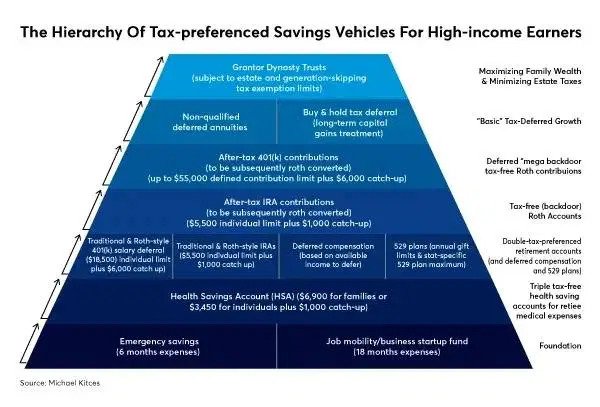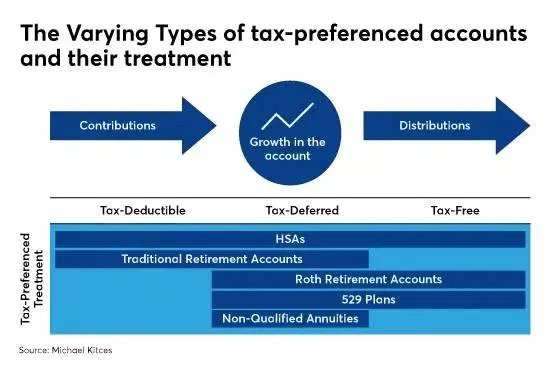The federal government has long incentivized saving by offering some combination of three tax preference types: deductibility, deferral and tax-free distributions. Yet for more affluent households, it’s a question of dialing in an optimal mix of tax-preferenced vehicles. To do that, a hierarchy is in order.
An optimal approach feeds the best preferenced accounts first, and as contribution limits are met, spills additional savings over to the next tier. When used in a holistic planning strategy, this hierarchical model can help high-income earners limit their tax liabilities and maximize growth.
At their core, tax-preferenced retirement accounts fit two archetypes: traditional accounts, which provide a tax deduction for contributions but ultimately tax the distributions; and Roth-style accounts, which are not deductible when contributions are made but are tax-free when distributed.
These retirement accounts are effectively double-tax-preferenced, in that they receive both tax-deferred status on assets in the account, plus either a deduction upfront or tax-free distribution treatment at the end.
Notably though, some tax-preferenced savings accounts are even better. HSAs are triple-tax-free accounts, providing tax-deductible contributions upfront, tax-deferred growth and tax-free distributions for qualified expenses. By contrast, a non-qualified annuity only offers one tier: tax-deferral, as contributions are not tax-deductible, nor are distributions tax-free.
Vehicle preference is simply based on whatever goals an individual is pursuing — whether it’s paying for medical expenses and health insurance deductibles, sending kids to college or saving for retirement. To the extent that dollars are limited, this is an exercise in building up an initial emergency reserve, then allocating scarce resources to whatever goals have the greatest priority, while hoping to make the rest up with future savings — and future income increases— down the road.
Households that might be earning $300,000 or more, however, tend to apply a different lens on these goals — whether it’s saving for retirement, building family wealth, paying for college or maximizing the economic value of the dollars being saved. The question for them is not whether a certain type of account can or will be used, but rather how it should be used in the holistic mix of things.
TIER 1: HSAs
The first and best place to commit to long-term tax-preferenced savings for high-income individuals is an HSA. The key to maximizing the HSA as a high-income savings account is to pay all actual medical expenses out of pocket, while also contributing to the HSA to cover future medical expenses. Treated in such a way, the HSA effectively becomes a supplemental retirement savings account earmarked to provide tax-free distributions for any deductible medical expenses described under IRC Section 213.
These include most long-term care expenses, co-pays and deductibles under Medicare in retirement, plus long-term care insurance premiums up to the age-based LTC premium limits and even Medicare Part B and Part D premiums — though not Medigap supplemental insurance premiums.
Of course, the caveat to having an HSA is that it’s only permitted for those who have a high-deductible health plan in the first place, with minimum deductibles of $1,350 for individuals and $2,700 for families, and maximum out-of-pocket costs as high as $6,650 for individuals and $13,300 for families. On the other hand, arguably most high-income households should have a high-deductible plan simply because they have the financial wherewithal to self-insure a larger deductible and have the cash flow available to cover the cost — on top of making their HSA contribution.
TIER 2: RETIREMENT
After the triple-tax-free HSA, the next tier consists of various double-tax-preferenced retirement accounts. High-income individuals tend to feel the pressure and impact of the top tax brackets, and as such typically prefer Roth-style accounts, which eliminate that tax bite on growth.
Ironically though, for most high-income individuals it’s actually better to contribute to a traditional account rather than a Roth, in order to get the upfront tax deduction at those current top tax rates. Indeed, a Roth retirement account only wins relative to a traditional account if the tax rates at the time of distribution are higher — or at least equal to — the tax rates at the time of contribution.
For those who are already in the top tax bracket, it’s difficult to achieve higher future tax rates. Even very affluent married couples have trouble reaching the $600,000 annual ordinary income level that would place them there. And despite fears of rising future tax rates given current budget deficits, the trend in Washington is toward actually lowering the top tax bracket — albeit while also trimming deductions.
Consequently, the Roth-style account really only suits those who are not just in the top tax bracket now, but will be there for life. These are households with $15 million-plus levels of net worth. For the rest, it’s better to get the tax deduction now, at top rates. Those who want a tax-free Roth in the long run should do partial Roth conversions later, i.e., after the wage/employment income ends and the tax bracket drops.
In practice, this means not contributing to a backdoor Roth IRA or Roth 401(k), and saving instead the $5,500 maximum (or $6,500 for those over age 50) into traditional pre-tax IRAs if possible. Very high-income individuals can only do so if neither they nor their spouse is already an active participant in an employer retirement plan, and are otherwise maximizing contributions up to the $18,500 limit — or $24,500 with catch-up contributions for those over age 50 — to a pre-tax 401(k) plan.
For high-income individuals who either own businesses or at least are sole proprietors filing a Schedule C, there are even more savings opportunities. Total contributions to a 401(k)-salary-deferral-plus-profit-sharing plan in the aggregate can be as high as $55,000. This effectively allows as much as another $36,500 in contributions above the $18,500 401(k) limit alone for those earning at least $270,000/year, in addition to another $6,000 in catch-up contributions. Even higher contributions may be feasible for those in their 50s or 60s who want to set up a supplemental defined benefit plan.
Notably however, business owners with employees must make contributions to other employees as well, which may reduce the value of making additional profit-sharing or defined benefit plan contributions, causing alternatives like a deferred compensation plan to look more appealing.
It’s also worth leveraging 529 college savings plans at this tier to maximize the opportunity for tax-free growth, especially for younger children who have a decade or more to benefit from tax-deferred compounding. In fact, for those who anticipate more than enough wealth to cover the family’s needs, additional funding into a 529 plan — up to the plan’s limits — is compelling, as the beneficiary can always be changed to other family members down the line.
TIER 3: TAX-FREE ROTHS
As noted earlier, most high-income individuals should maximize pre-tax retirement accounts first — and at best, only contribute to Roth-style accounts later via a partial Roth conversion. The caveat is that high-income individuals who aren’t business owners will be capped at $18,500 of annual 401(k) contributions barring catch-ups, and at that point may not be able to make a pre-tax contribution to a traditional retirement account at all.
In such situations, making an after-tax contribution to a non-deductible IRA is still viable, and helps avoid the 3.8% Medicare surtax on investment growth. As for high-income individuals, direct Roth contributions are not feasible due to the Roth income limits.
There are no such limits to backdoor Roth contributions, but it is still important to navigate around the IRA aggregation rule that can cause non-deductible IRA contributions to become partially taxable — unless the other dollars are first rolled into a separate 401(k) plan — and wait a reasonable time period (e.g., 12 months) between the non-deductible IRA contribution and subsequent conversion to avoid the step transaction doctrine. Single-earner-high-income couples should also bear in mind that a non-working spouse can make non-deductible IRA contributions that are subsequently converted to a Roth under the Spousal IRA rules.
TIER 4: GOING MEGA
The next option is a deferred Roth contribution, also sometimes called the mega-backdoor Roth.
Popularized after IRS Notice 2014-54 explicitly permitted it, the mega-backdoor Roth makes after-tax contributions to a 401(k) plan — above and beyond the traditional salary deferral that can be done pre-tax — that are later converted to a Roth once the money can be rolled out of the plan either at retirement or as an in-service distribution where permitted.
As the name implies, the contribution limits are significantly higher — starting above the $18,500 pre-tax salary deferral limit and extending all the way up to the $55,000 contribution limit for total dollars into any defined contribution plan, for a potential maximum mega-backdoor Roth contribution as high as $36,500.
However, several caveats reduce its appeal relative to the preceding tiers.
The biggest: While IRS Notice 2014-54 permitted after-tax contributions to be converted to a Roth account, the tax-free status doesn’t begin until the dollars are converted to a Roth. This means they need to leave the employer retirement plan.
Consequently, the mega-backdoor Roth is often considered a deferred Roth contribution, a distinction that isn’t earned until either the employee retires or at least separates from service — unless the plan allows in-service distributions.
In addition, the $55,000 limit for all contributions includes both the $18,500 salary deferral limit, after-tax contributions and profit-sharing or other employer pre-tax contributions. Employers that make profit-sharing or salary-matching contributions reduce the remaining availability of making after-tax contributions.
There is also at least some risk that Congress will eliminate the ability to convert after-tax dollars. Such a regulation has already been proposed once. Nonetheless, the worst case scenario is that the after-tax contributions will grow tax-deferred, similar to other non-deductible contributions further down the hierarchy.
TIER 5: BASIC GROWTH
These high-income savings vehicles don’t provide any upfront tax deduction or tax-free distributions, but do allow for tax-deferred growth.
The most common vehicle at this tier is the non-qualified deferred annuity, which when held outside a retirement account provides tax-deferred growth. That said, as an annuity there is an additional cost for the annuity guarantees and the tax deferral wrapper.
The good news is that for high-income individuals who just want tax deferral, there are a growing number of Investment-Only Variable Annuity, or IOVA, contracts that have few guarantees, which gives them a very low cost — sometimes just 0.50%/year or even lower — and makes it worthwhile to pay them just for the tax-deferral treatment.
Classically, permanent cash value life insurance has also been used as a tax deferral vehicle, absorbing the costs of life insurance death benefits to access the tax-deferred growth treatment available, where the growth is subsequently borrowed against to avoid triggering tax consequences on distribution.
Yet it’s impossible to borrow and use all the cash value, lest the policy lapse and cause a substantial tax consequence. Furthermore, in today’s environment annuities are often inexpensive enough that the insurance may not represent a pure tax-deferral strategy. At best it must be carefully designed to allow a maximal internal rate of return.
As a result, cash value life insurance is more commonly used for at least those who have a blended need for savings and a death benefit, for ultra-high-net-worth investors who can access lower-cost private placement life insurance policies — albeit with a higher upfront cost that keeps them impractical for most — or simply those wanting to maximize the tax-free death benefit of the life insurance and don’t actually care about using the cash value.
The good old-fashioned taxable brokerage account can also be a tax-deferred growth vehicle, at least for long-term growth assets — because capital gains aren’t taxable until holdings are sold. In fact, a zero-dividend growth stock held until liquidation gets the same tax-deferral treatment as an annuity, but without the cost of the annuity wrapper.
Unfortunately, investments with a non-trivial dividend and even a modest level of ongoing turnover can experience enough tax drag to make them less appealing. Nonetheless, for buy-and-hold investors of long-term growth stocks — or certain tax-managed mutual funds or even real estate — sometimes it’s not actually necessary to find an alternative, as capital gains themselves are tax-deferred as long as there’s a plan for how to unwind them.
TIER 6: DYNASTY TRUSTS
For those who want to further maximize tax-preferenced growth with additional savings, there’s the grantor dynasty trust.
These are not necessarily income tax savings vehicles. In fact, trusts face a top tax bracket of 37% at just $12,500 of taxable income, making such compressed trust tax rates worse — or at best, no better — than what high-income households already face.
Instead, the tax savings appeal of a dynasty trust comes in structuring it as a grantor trust, which makes the income tax consequences remain at the levels of the original grantor, even after the dollars have been gifted/transferred into the trust. This means the grantor is unmoved — paying taxes on any growth in the trust that would have been paid by just keeping the money and investing it.
This approach allows the grantor to use dollars in their estate to pay the income tax bill for a trust that is growing outside of his/her estate — permissible under Revenue Ruling 2004-64. So while the grantor ends up in the same position, the dynasty trust effectively grows income-tax-free because it’s paid by the grantor, and estate-tax-free since it’s a dynasty trust.
CAREER CONSIDERATIONS
Notwithstanding these six tiers, having a healthy emergency fund and disability insurance are paramount.
Income can drop unexpectedly even for high earners, and being compelled to liquidate tax-preferenced accounts can leave a household worse off than having just skipped tax-preferenced accounts altogether. That’s not to mention the growing base of research that shows having reasonable cash on hand increases our happiness.
And the ideal may not just be the classic six-month emergency fund, but an additional 18 months to allow for job mobility and business/career opportunities. There’s nothing more freeing about making good career decisions than knowing you can take risks and still have an ample cushion to fall back on.
The greatest wealth creation opportunity for those who are still working is the chance of finding a job or starting a business that creates even better earnings. Put another way, the best tax-deferred savings strategy may just be you investing in your own human capital.

Vehicle preference is simply based on whatever goals an individual is pursuing — whether it’s paying for medical expenses and health insurance deductibles, sending kids to college or saving for retirement. To the extent that dollars are limited, this is an exercise in building up an initial emergency reserve, then allocating scarce resources to whatever goals have the greatest priority, while hoping to make the rest up with future savings — and future income increases — down the road.
Households that might be earning $300,000 or more, however, tend to apply a different lens on these goals — whether it’s saving for retirement, building family wealth, paying for college or maximizing the economic value of the dollars being saved. The question for them is not whether a certain type of account can or will be used, but rather how it should be used in the holistic mix of things.
TIER 1: HSAs
The first and best place to commit to long-term tax-preferenced savings for high-income individuals is an HSA. The key to maximizing the HSA as a high-income savings account is to pay all actual medical expenses out of pocket, while also contributing to the HSA to cover future medical expenses. Treated in such a way, the HSA effectively becomes a supplemental retirement savings account earmarked to provide tax-free distributions for any deductible medical expenses described under IRC Section 213.
These include most long-term care expenses, co-pays and deductibles under Medicare in retirement, plus long-term care insurance premiums up to the age-based LTC premium limits and even Medicare Part B and Part D premiums — though not Medigap supplemental insurance premiums.
Of course, the caveat to having an HSA is that it’s only permitted for those who have a high-deductible health plan in the first place, with minimum deductibles of $1,350 for individuals and $2,700 for families, and maximum out-of-pocket costs as high as $6,650 for individuals and $13,300 for families. On the other hand, arguably most high-income households should have a high-deductible plan simply because they have the financial wherewithal to self-insure a larger deductible and have the cash flow available to cover the cost — on top of making their HSA contribution.

TIER 2: RETIREMENT
After the triple-tax-free HSA, the next tier consists of various double-tax-preferenced retirement accounts. High-income individuals tend to feel the pressure and impact of the top tax brackets, and as such typically prefer Roth-style accounts, which eliminate that tax bite on growth.
Ironically though, for most high-income individuals it’s actually better to contribute to a traditional account rather than a Roth, in order to get the upfront tax deduction at those current top tax rates. Indeed, a Roth retirement account only wins relative to a traditional account if the tax rates at the time of distribution are higher — or at least equal to — the tax rates at the time of contribution.
For those who are already in the top tax bracket, it’s difficult to achieve higher future tax rates. Even very affluent married couples have trouble reaching the $600,000 annual ordinary income level that would place them there. And despite fears of rising future tax rates given current budget deficits, the trend in Washington is toward actually lowering the top tax bracket — albeit while also trimming deductions.
Consequently, the Roth-style account really only suits those who are not just in the top tax bracket now, but will be there for life. These are households with $15 million-plus levels of net worth. For the rest, it’s better to get the tax deduction now, at top rates. Those who want a tax-free Roth in the long run should do partial Roth conversions later, i.e., after the wage/employment income ends and the tax bracket drops.
In practice, this means not contributing to a backdoor Roth IRA or Roth 401(k), and saving instead the $5,500 maximum (or $6,500 for those over age 50) into traditional pre-tax IRAs if possible. Very high-income individuals can only do so if neither they nor their spouse is already an active participant in an employer retirement plan, and are otherwise maximizing contributions up to the $18,500 limit — or $24,500 with catch-up contributions for those over age 50 — to a pre-tax 401(k) plan.
For high-income individuals who either own businesses or at least are sole proprietors filing a Schedule C, there are even more savings opportunities. Total contributions to a 401(k)-salary-deferral-plus-profit-sharing plan in the aggregate can be as high as $55,000. This effectively allows as much as another $36,500 in contributions above the $18,500 401(k) limit alone for those earning at least $270,000/year, in addition to another $6,000 in catch-up contributions. Even higher contributions may be feasible for those in their 50s or 60s who want to set up a supplemental defined benefit plan.
Notably however, business owners with employees must make contributions to other employees as well, which may reduce the value of making additional profit-sharing or defined benefit plan contributions, causing alternatives like a deferred compensation plan to look more appealing.
It’s also worth leveraging 529 college savings plans at this tier to maximize the opportunity for tax-free growth, especially for younger children who have a decade or more to benefit from tax-deferred compounding. In fact, for those who anticipate more than enough wealth to cover the family’s needs, additional funding into a 529 plan — up to the plan’s limits — is compelling, as the beneficiary can always be changed to other family members down the line.
TIER 3: TAX-FREE ROTHS
As noted earlier, most high-income individuals should maximize pre-tax retirement accounts first — and at best, only contribute to Roth-style accounts later via a partial Roth conversion. The caveat is that high-income individuals who aren’t business owners will be capped at $18,500 of annual 401(k) contributions barring catch-ups, and at that point may not be able to make a pre-tax contribution to a traditional retirement account at all.
In such situations, making an after-tax contribution to a non-deductible IRA is still viable, and helps avoid the 3.8% Medicare surtax on investment growth. As for high-income individuals, direct Roth contributions are not feasible due to the Roth income limits.
There are no such limits to backdoor Roth contributions, but it is still important to navigate around the IRA aggregation rule that can cause non-deductible IRA contributions to become partially taxable — unless the other dollars are first rolled into a separate 401(k) plan — and wait a reasonable time period (e.g., 12 months) between the non-deductible IRA contribution and subsequent conversion to avoid the step transaction doctrine. Single-earner-high-income couples should also bear in mind that a non-working spouse can make non-deductible IRA contributions that are subsequently converted to a Roth under the Spousal IRA rules.
TIER 4: GOING MEGA
The next option is a deferred Roth contribution, also sometimes called the mega-backdoor Roth.
Popularized after IRS Notice 2014-54 explicitly permitted it, the mega-backdoor Roth makes after-tax contributions to a 401(k) plan — above and beyond the traditional salary deferral that can be done pre-tax — that are later converted to a Roth once the money can be rolled out of the plan either at retirement or as an in-service distribution where permitted.
As the name implies, the contribution limits are significantly higher — starting above the $18,500 pre-tax salary deferral limit and extending all the way up to the $55,000 contribution limit for total dollars into any defined contribution plan, for a potential maximum mega-backdoor Roth contribution as high as $36,500.
However, several caveats reduce its appeal relative to the preceding tiers.
The biggest: While IRS Notice 2014-54 permitted after-tax contributions to be converted to a Roth account, the tax-free status doesn’t begin until the dollars are converted to a Roth. This means they need to leave the employer retirement plan.
Consequently, the mega-backdoor Roth is often considered a deferred Roth contribution, a distinction that isn’t earned until either the employee retires or at least separates from service — unless the plan allows in-service distributions.
In addition, the $55,000 limit for all contributions includes both the $18,500 salary deferral limit, after-tax contributions and profit-sharing or other employer pre-tax contributions. Employers that make profit-sharing or salary-matching contributions reduce the remaining availability of making after-tax contributions.
There is also at least some risk that Congress will eliminate the ability to convert after-tax dollars. Such a regulation has already been proposed once. Nonetheless, the worst case scenario is that the after-tax contributions will grow tax-deferred, similar to other non-deductible contributions further down the hierarchy.
TIER 5: BASIC GROWTH
These high-income savings vehicles don’t provide any upfront tax deduction or tax-free distributions, but do allow for tax-deferred growth.
The most common vehicle at this tier is the non-qualified deferred annuity, which when held outside a retirement account provides tax-deferred growth. That said, as an annuity there is an additional cost for the annuity guarantees and the tax deferral wrapper.
The good news is that for high-income individuals who just want tax deferral, there are a growing number of Investment-Only Variable Annuity, or IOVA, contracts that have few guarantees, which gives them a very low cost — sometimes just 0.50%/year or even lower — and makes it worthwhile to pay them just for the tax-deferral treatment.
Classically, permanent cash value life insurance has also been used as a tax deferral vehicle, absorbing the costs of life insurance death benefits to access the tax-deferred growth treatment available, where the growth is subsequently borrowed against to avoid triggering tax consequences on distribution.
Yet it’s impossible to borrow and use all the cash value, lest the policy lapse and cause a substantial tax consequence. Furthermore, in today’s environment annuities are often inexpensive enough that the insurance may not represent a pure tax-deferral strategy. At best it must be carefully designed to allow a maximal internal rate of return.
As a result, cash value life insurance is more commonly used for at least those who have a blended need for savings and a death benefit, for ultra-high-net-worth investors who can access lower-cost private placement life insurance policies — albeit with a higher upfront cost that keeps them impractical for most — or simply those wanting to maximize the tax-free death benefit of the life insurance and don’t actually care about using the cash value.
The good old-fashioned taxable brokerage account can also be a tax-deferred growth vehicle, at least for long-term growth assets — because capital gains aren’t taxable until holdings are sold. In fact, a zero-dividend growth stock held until liquidation gets the same tax-deferral treatment as an annuity, but without the cost of the annuity wrapper.
Unfortunately, investments with a non-trivial dividend and even a modest level of ongoing turnover can experience enough tax drag to make them less appealing. Nonetheless, for buy-and-hold investors of long-term growth stocks — or certain tax-managed mutual funds or even real estate — sometimes it’s not actually necessary to find an alternative, as capital gains themselves are tax-deferred as long as there’s a plan for how to unwind them.
TIER 6: DYNASTY TRUSTS
For those who want to further maximize tax-preferenced growth with additional savings, there’s the grantor dynasty trust.
These are not necessarily income tax savings vehicles. In fact, trusts face a top tax bracket of 37% at just $12,500 of taxable income, making such compressed trust tax rates worse — or at best, no better — than what high-income households already face.
Instead, the tax savings appeal of a dynasty trust comes in structuring it as a grantor trust, which makes the income tax consequences remain at the levels of the original grantor, even after the dollars have been gifted/transferred into the trust. This means the grantor is unmoved — paying taxes on any growth in the trust that would have been paid by just keeping the money and investing it.
This approach allows the grantor to use dollars in their estate to pay the income tax bill for a trust that is growing outside of his/her estate — permissible under Revenue Ruling 2004-64. So while the grantor ends up in the same position, the dynasty trust effectively grows income-tax-free because it’s paid by the grantor, and estate-tax-free since it’s a dynasty trust.
CAREER CONSIDERATIONS
Notwithstanding these six tiers, having a healthy emergency fund and disability insurance are paramount.
Income can drop unexpectedly even for high earners, and being compelled to liquidate tax-preferenced accounts can leave a household worse off than having just skipped tax-preferenced accounts altogether. That’s not to mention the growing base of research that shows having reasonable cash on hand increases our happiness.And the ideal may not just be the classic six-month emergency fund, but an additional 18 months to allow for job mobility and business/career opportunities. There’s nothing more freeing about making good career decisions than knowing you can take risks and still have an ample cushion to fall back on.
The greatest wealth creation opportunity for those who are still working is the chance of finding a job or starting a business that creates even better earnings. Put another way, the best tax-deferred savings strategy may just be you investing in your own human capital.
Businesses also create enterprise value that is tax-deferred until the business is sold. Moreover, a business converts ordinary income into capital gains, and potentially introduces special tax benefits under IRC Section 1202.
And so while it’s important to maximize the tax-preferenced vehicles available for high-income earners, it’s also critical to create a job mobility/business start-up fund as well. It has clear tax benefits, and arguably the greatest wealth creation potential of all.
By Michael Kitces
Published August 06 2018, 3:33pm EDT
If you have any questions regarding this article, or if you need further assistance regarding your unique financial or tax situation, send us an email at info@zagmoutcpas.com, or call us at (312) 239-3716.
To learn more, visit Zagmout & Company CPAs at www.zagmoutcpas.com.


